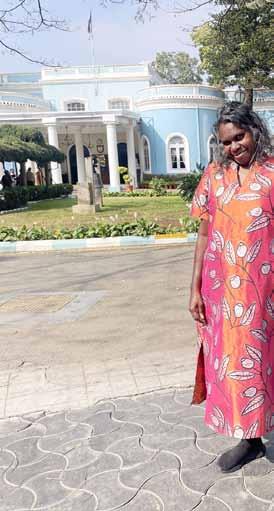
4 minute read
Hunting paedophiles
from 2023-02 Sydney
by Indian Link
BY Prutha Chakraborty
When Indian-Australian filmmaker Akhim Dev wrote and directed his documentary The Children in the Pictures in 2021, he had no idea the project would change his life forever.
Based on the Queensland Police Task Force Argos, which rescues children from online sexual exploitation, the film went on to score a Golden Globes nomination, win multiple awards, even spawn a podcast.
It has now become a project that every parent is urged to engage with. Children are spending more time on the Internet than ever before. Around the world, a child goes online for the first time every half second, according to UNICEF.
Online child exploitation is a silent epidemic.
One in three children is approached online by someone they do not know. These predators use the dark web to find vulnerable children. One such website where the IP address is masked, is The Love Zone. Now shuttered, this pornography site was at the centre of Akhim Dev’s documentary and podcast.

The Children In The Pictures follows Task Force Argos into The Love Zone. Its 45,000 members, paedophiles, were creating, uploading, and sharing videos and photographic material of unimaginable acts against kids.

“The film is an historical top-down view of the crime type and its evolution in a 20-year tech timeline from dial up Internet to mobile broadband, through the lens of Argos,” Dev tells Indian Link. “The podcast is a deep-dive into Argos’ first dark web network infiltration. The podcast format allows us to address issues in more detail and is an incredible format for storytelling with a social prerogative.”
“Everything came about from the willingness of the international law enforcement community to collaborate with us and let us in to their world,” he shares.
“It has resulted in screenings at the UN, in 150 countries, at the US Congress and in the Australian Parliament.”
Now, Dev says he has plans for India too, “where this problem has exploded”.
Ak HIM DEV: TRYST wITH STORYTELLING
Dev’s roots are from Chennai in India. His grandfather was the Governor of Bombay. His family moved to Australia in 1971 when the White Australia policy was prevalent. Growing up, he was expected to pursue a traditional occupation.
Quite serendipitously, his career in documentary films was launched after he moved back to southern India in 1994. “I wanted to take over my father’s magnet manufacturing business,” he recalls. “An hour out of Chennai, in the old port city of Mamallapuram, I built a small beach shack and surfed incredible uncrowded waves.”
One day, Dev was washed down the beach and met a seven-year-old girl, who led him to a gypsy camp. Called the Vaghri, the members living in this camp are known for stripping the skin off wild cats. “I borrowed a camera and editing gear from a Bollywood studio and made my first short film on these gypsies. This project got my acceptance in the Australian Film Television and Radio School in Moore Park.”
Today, Dev has Storm Surfers and The 3G of Us to his credit.
ARGOS: A NET wORk TO bREA k A NET wORk
A research project about high-risk reoffenders led Dev to making The Children In The Pictures. “I had seen images and videos traded among members of huge organised networks of child abusers,” Dev informs. “I had to see this disturbing content to realise exactly what our children are facing. This is the most serious form of abuse committed by the most dangerous sex offenders.”
Initially, Dev couldn’t believe what he was discovering. He wondered – why wasn’t anyone covering this? “It was all out there in the public domain, but I don’t think anyone had realised the sheer scale.”
Luckily, Dev also found out about the Task Force Argos who were nailing these criminals. That gave him a glimmer of hope. “Not only are they great at what they do, they are plugged into a global network of dedicated child protection experts.”
Argos was the first law agency to take over an abuse network – in an effort to rescue as many victims as possible. Dev contacted the investigators, and told them he wanted to tell their story.
“The project had challenges,” he says. “How do you talk about something so horrific in a way that we can engage the audience and not make them run screaming? How do you describe the indescribable and not sensationalise it? Most importantly, how do we honour the memories of so many child sexual abuse survivors?”
The filming took a toll on Dev’s mental health, especially since he is a father.
“The project impacted my parenting,” he confesses. “It took a long time to not be paranoid of any interaction my youngest – now 7 – was having with anyone. Statistically, the chances of her being abused by someone in the ‘real’ world is about the same as when I was a child. What has changed is technology. Smart phones have allowed an abuser direct and unfettered access to children.”
To recuperate from the horrors of abuse, Dev had to turn to counselling and transcendental Vedic meditation.
“We cannot reverse the Internet, but we can teach our children how to navigate safely. Awareness is key to reduce the incidence.”
And so, Akhim Dev wants to take this docu series and podcast to as many parents as possible.
“We will continue to work with the Australian Centre To Counter Child Exploitation and the eSafety commissioner in Australia, and with the UN, until we are not needed. Unfortunately, that does not look to be anytime soon.”
BY PRUTHA CHAKRABORTY
Jarracharra, an exhibition of traditional textile art from Australia’s western Arnhem Land region, is currently on in Mumbai, as part of the city’s famed Kala Ghoda Arts Festival.
An initiative of the Bábbarra Women’s Centre (Bábbarra Designs), a world-class textile producing art centre, it takes to India its particular style of art – beautiful landscapes, spirit beings, bush foods and crafts from its region.

Incorporating rock themes, food collecting traditions, and the sacred sites on their land, their textile art is a wonderful introduction to their world, Jarracharra follows a highly successful international season that began in Paris in 2019, when five Aboriginal artists from Maningrida – a community based in Australia’s western Arnhem Land region –took it there. It was the year that the United Nations had declared as the International Year of Indigenous Languages, to encourage the world to appreciate the significant contribution









